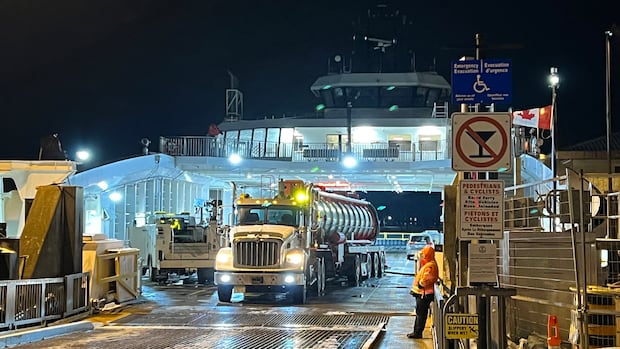Conflicting reports reveal fresh information about the Wolfe Island Ferry crashThrough freedom of information requests, CBC obtained reports into the grounding of the vessel in Kingston, Ont., one of which states investigators were missing key pieces of information.Ontario’s Ministry of Transportation (MTO) failed to retrieve data it acknowledged was “crucial” for accident investigators after the Wolfe Islander IV ran aground, preventing a full review of the crash that tore a hole in the ferry’s hull.The vessel was carrying 58 passengers and crew when it went off course, entered shallow waters, then gashed its hull on rocks and mud shortly after leaving Marysville, Ont. on a windy day last December.It continued toward Kingston, eventually taking on approximately 70,000 litres of water — about the volume of a backyard swimming pool. No one was injured.What followed were months spent waiting for repairs and information from the ministry about how the new, electric ferry was damaged. Meanwhile, island residents who rely on the service were left guessing at what happened.Now, two documents obtained by CBC through freedom of information requests and made public for the first time provide conflicting explanations for the crash.A MTO investigation concluded it was the result of a combination of factors including “a delayed response from the Bridge team, environmental conditions and navigational challenges,” while a report from the ship’s captain blamed underpowered thrusters.Further complicating matters, the MTO report notes investigators were working without two key pieces of information.’Very poor as an organization’A brand new vessel, the WI4 is packed with technology, including two Electronic Chart Display and Information System units (ECDIS), which show and log the its location in real-time, like a GPS.Also onboard is a Voyage Data Recorder (VDR), a device comparable to an airplane’s “black box.”The Wolfe Islander IV ferry is shown at the dock in Marysville, Ont. on Oct. 7, 2025. (Dan Taekema/CBC)The VDR securely stores information about the vessel’s position, movement and command decisions for a period of 30 days, according to the MTO report. “This objective data is crucial for accident investigators to reconstruct events, identify operational issues, and analyze human factors contributing to incidents,” it reads.However, data from both the VDR and the ECDIS units were not retrieved within the 30-day deadline, the MTO found.Those failures “prevented a full post-incident review,” the report stated, without explaining why the information wasn’t collected.It was up to MTO to retain that data, said John Dalziel, an adjunct professor of industrial engineering at Dalhousie University, where one of his focuses is marine safety.”I think it was very poor as an organization not to save it,” he said.That mistake is enough to make the MTO’s investigation “unreliable,” according to Lee MacLaren, president of OPSEU Local 428, which represents ferry workers.Lee MacLaren, is president of OPSEU Local 428, which represents ferry Wolfe Island ferry workers. He’s also a captain with 15 years of experience. (Dan Taekema/CBC)He was aboard during the crash, though off duty. A captain himself, with 15 years of experience, MacLaren said he’s “baffled” the ministry didn’t secure that data.“Those pieces of equipment are there for this type of situation, in order to have people debrief properly, to avoid similar situations happening again,” he said.MTO said no one was available for an interview. It also did not respond directly to a list of questions, including why the VDR and ECDIS data weren’t retrieved and how it could be confident in its findings without that information.’Navigational error’Despite not having that data, MTO described its investigation as “extensive.”It found the immediate cause of the crash was a navigational error by the bridge team, which it said did not actively monitor the route or compensate for wind.Investigators also said a passage plan — the route the ferry would follow — hadn’t been entered into the ECDIS, meaning warning systems didn’t sound.The ministry listed “poor situational awareness” and a communication breakdown as other factors.Members of the Wolfe Islander IV crew could be seen on the bridge after the ferry was damaged on Dec. 4, 2024. (Dan Taekema/CBC)The captain of the ferry had a different explanation in his account of the crash, also obtained by CBC through freedom of information laws. In a marine occurrence report filed with the Transportation Safety Board, he stated the wind blew the vessel off course and when he tried to correct it, the electric thrusters were “unable to provide the propulsion required” before it was too late.Islanders worry about winter windsThat scenario worries some islanders who worry the new ferry is a “fair-weather boat,” according to Leesa Owram.She’s part of a grassroots group called Better Service for Wolfe Islanders and said it was “quite catastrophic” to hear the hull had been damaged.Owram said islanders love the look of the new boat, and some who have lived there longer are urging newer residents to be patient as its crew works out the kinks.Leesa Owram is part of a grassroots group called Better Service for Wolfe Islanders. She says residents want better communication from MTO and a ferry they can rely on. (Dan Taekema/CBC)But, she said, better communication from MTO would help.“It’s like having a new boyfriend. You have to learn to trust it,” she said of the ferry.People want to know the vessel is capable, she said: “Will the boat be able to handle some of our winds, our storms?”’Competency Gaps’MTO acknowledges the new ferry is different from the old one. Its report states the WI4’s electric drive comes with torque limits to protect the propulsion system.“This approach maintains safe and sustainable performance, limiting the ability to ‘muscle’ the vessel as seen in previous ferries,” it reads.The hull design also “significantly impacts its maneuverability” because it has a keel. That increases stability compared to flat-bottomed boats but creates resistance when moving sideways.Those two factors require a different approach to steering.“Captains must anticipate turns earlier and apply more gradual adjustments rather than relying on brute force to negotiate tight maneuvers,” the MTO said.That came into play on Dec. 4. when the ministry said the ferry was operating in “suboptimal” conditions, involving snow, moderate visibility and winds up to 45 km/h.Given the situation, “continuous assessment and adjustment” of the vessel’s track should have been made, the MTO concluded, adding that “increased situational awareness in the wheelhouse, could have influenced the timing and effectiveness of corrective actions.”However, the ministry acknowledged that given the WI4 was newly in service, crew members didn’t have much experience handling it in rough conditions.Training protocols for the boat running aground had also not been integrated, the MTO found in a section titled “Training & Competency Gaps.” It’s a grim reminder of how dangerous the job can be.- Lee MacLaren, President OPSEU Local 428Dalziel, the professor who teaches marine safety, said he sees a lack of experience and training as “almost the biggest failure in this whole thing,” noting the channel the ferry uses doesn’t leave much room for error.MacLaren, the union president, said in his opinion the new vessel is “grossly underpowered,” describing that as a “great concern” for crews with winter coming.“When you’re in tight situations or in narrow channels, there is a problem with gusts of wind putting you in places that no matter how good you are at handling the ship, you may simply not be able to get out of that situation due to the ship’s capabilities,” he said.Work crews and a tanker truck could be seen on the deck of the Wolfe Islander IV around 5:30 p.m. on Dec. 4, 2024, hours after Ontario’s Ministry of Transportation said the ferry was damaged while en route to Kingston. (Dan Taekema/CBC)Ministry says it added ‘safeguards’ after reviewIn its statement to CBC, ministry spokesperson Julia Caslin said the safe operation of the ferry is its “highest priority.”“The Wolfe Islander IV has been designed and built for operation in local conditions, including varying weather conditions,” she wrote, adding following its review MTO has added “safeguards” for the vessel.“These include updated marine surveys along the navigation channel, additional buoys to mark the channel, and additional scenario-based drills and enhanced training programs for all ferry crews.”Those measures were among a list of 19 actions the ministry proposed in its report, along with mandated retrieval and archiving ECDIS and VDR data after any future crashes.Workers could be seen feeding a hose over the side of the ferry shortly after noon on Dec. 4, 2024. (Dan Taekema/CBC)MacLaren said those steps should have been taken before the grounding.He agreed crews could use more training, especially when it comes to rough weather or emergencies, but said this yet to materialize.While no one was hurt when the ferry bottomed out, MacLaren said had the hole been punched in a slightly different part of the hull, it would have flooded a main engine room.“That could have destroyed millions of dollars in equipment … as well as caused a way more dangerous situation in the stability of the ship as the water was coming in,” he said.“It’s a grim reminder of how dangerous the job can be.”
Thursday, 27 Nov 2025
Canada – The Illusion
Search
Have an existing account?
Sign In
© 2022 Foxiz News Network. Ruby Design Company. All Rights Reserved.
You May also Like
- More News:
- history
- Standing Bear Network
- John Gonzalez
- ᐊᔭᐦᑊ ayahp — It happened
- Creation
- Beneath the Water
- Olympic gold medal
- Jim Thorpe
- type O blood
- the bringer of life
- Raven
- Wás’agi
- NoiseCat
- 'Sugarcane'
- The rivers still sing
- ᑲᓂᐸᐏᐟ ᒪᐢᑿ
- ᐅᑳᐤ okâw — We remember
- ᐊᓂᓈᐯᐃᐧᐣ aninâpêwin — Truth
- This is what it means to be human.
- Nokoma












